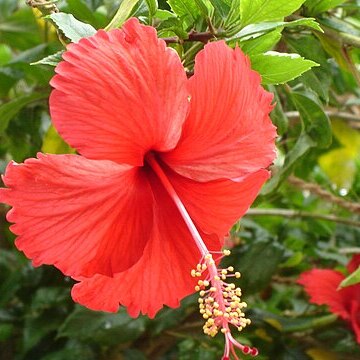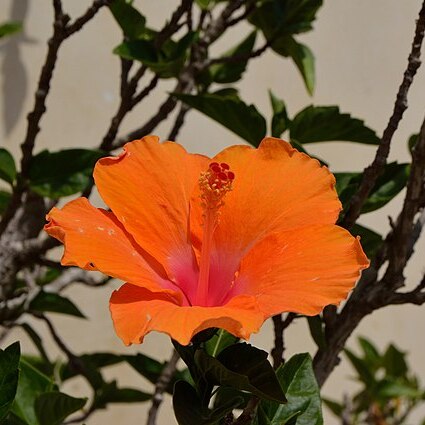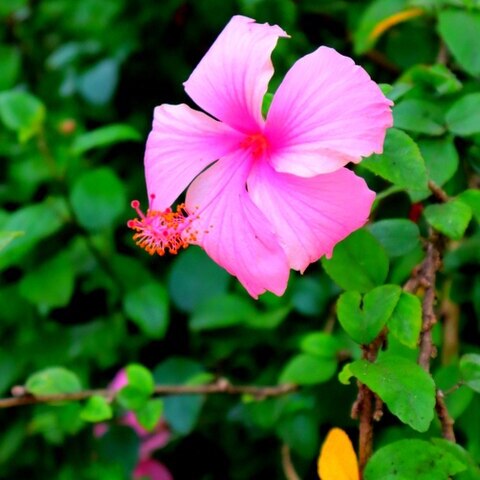Herbs, annual or perennial, or shrubs or infrequently small to medium-sized trees, the indumentum of simple or stellate hairs, sometimes aculeate. Leaves petiolate, the blade simple to palmatilobed or palmatiparted, the venation palmate, sometimes with a dorsal gland near the base of the midrib. Flowers axillary, soli-tary or forming racemose, paniculate or fasciculate inflorescences, medium or large and showy, the pedicels often articulated; epicalyx usually of numerous bractlets, rarely 2-5 bractlets, occasionally absent or very minute, the bractlets distinct or more or less united at the base, sometimes adnate to the base of the calyx, generally persistent or even accrescent; calyx 5-merous, cupuliform, campanulate or tubular, dentate or lobed,-the midvein of each lobe sometimes bearing a gland, generally persistent or even accrescent; petals contorted, more or less unguiculate, adnate to the base of the staminal tube, variously colored; staminal tube usually elongate, shorter to longer than the corolla, antheriferous throughout or only on the upper part below the 5-lobulate or truncate apex, the filaments long and spreading or short (anthers subsessile); anthers numerous, reniform or hippocrepiform; ovary (4-)5-locular, with 3 to many ovules in each locule, the ovules anatropous (some-times amphitropous?); style branches 5, these slender and mostly spreading; stig-mas capitate, papillate or fimbrillate. Fruit a loculicidally dehiscent capsule gen-erally surrounded by the persistent or accrescent epicalyx and calyx; seeds subglo-bose to reniform, sometimes angulate, glabrous or variously pubescent.
Shrubs, subshrubs, trees, or herbs. Leaf blade palmately lobed or entire, basal veins 3 or more. Flowers axillary, usually solitary, sometimes subterminal and ± congested into a terminal raceme, 5-merous, bisexual. Epicalyx lobes 5 to many, free or connate at base, rarely very short (H. schizopetalus) or absent (H. lobatus). Calyx campanulate, rarely shallowly cup-shaped or tubular, 5-lobed or 5-dentate, persistent. Corolla usually large and showy, variously colored, often with dark center; petals adnate at base to staminal tube. Filament tube well developed, apex truncate or 5-dentate; anthers throughout or only on upper half of tube. Ovary 5-loculed or, as a result of false partitions, 10-loculed; ovules 3 to many per locule; style branches 5; stigmas capitate. Fruit a capsule, cylindrical to globose, valves 5, dehiscence loculicidal and sometimes partially septicidal or indehiscent (H. vitifolius Linnaeus). Seeds reniform, hairy or glandular verrucose.
Herbs, shrubs or trees, variously pubescent, usually with stellate hairs (also aculei, bristles and glandular hairs). Leaves simple or palmately lobed, entire or usually toothed, petiolate, variously pubescent; stipules present, persistent or shedding with age. Flowers showy, axillary and solitary or in apparently terminal racemes or corymbs by reduction of upper leaves; pedicels usually articulate. Epicalyx segments 3–many, free or basally connate. Calyx 5-lobed, campanulate to suburceolate. Petals yellow, white, orange, red or purple, sometimes with basal petal spot. Staminal column fused, 5-lobed at apex; anthers inserted along column. Carpels 5, in a flat whorl, sometimes each divided vertically to give 10 cells, each with 3 or more ovules; style 5-branched, exserted from staminal column, stigmas captitate, hairy. Fruit a loculicidally dehiscent capsule, hairy. Seeds reniform or subreniform, glabrous to conspicuously hairy.
Bractlets of the epicalyx numerous, commonly about 12, linear; stamen-column with anthers along the sides; style-column prolonged, bearing 5 short branches with capitate stigmas; cor large; ovary 5-locular; ovules several in each locule; fr a subglobose to ovoid or prismatic, loculicidal capsule subtended or enclosed by the persistent, accrescent cal; seeds glabrous or roughened or hairy; annual or perennial herbs or shrubs, mostly with large fls. 200+, mostly warm reg.
Fls perfect, 5-merous, axillary or terminal, solitary to paniculate; involucre of few to several bracts. Calyx 5-toothed; petals adnate to staminal column; anthers attached below the apex. Fr. a dry ± dehiscent capsule. Herbs, shrubs or trees with palmately veined or lobed lvs. Widespread genus of perhaps some 200 spp. It is doubtful whether either spp. found in N.Z. is indigenous; both are now rather rare.
Annual to perennial herbs, shrubs or trees. Lvs lobed or not, usually toothed. Fls axillary and solitary, or in axillary or terminal infls; epicalyx segments 6-13, free or united; calyx evenly 5-toothed; petals spreading, usually obtuse. Style branches as many as loculi, dilated to capitate stigma. Fr. a 5-celled capsule; cells 3-or more seeded, dehiscent, not separating from axis at maturity.
Flowers usually solitary, axillary and often forming terminal racemose or corymbose inflorescences by reduction of the upper leaves, medium to large, often yellow with a dark centre or red, pink, purplish or white; peduncle usually articulated.
Annual or perennial herbs (sometimes with annual shoots arising from woody rootstocks or underground stems), shrublets, shrubs or (rarely) small trees.
Calyx 5-merous, usually with 5 lobes (or rarely 5 or 10 teeth) joined at the base or more rarely almost to the apex, persistent.
Fruit a loculicidally dehiscent capsule.– Capsule winged or with very prominent angles (TAB. 89 fig. 2)Series 13 (Pterocarpus).
Epicalyx (occasionally absent) of 5–20 bracts very variable in shape and length, free or adnate to the base of the calyx.
Staminal tube truncate at the apex; free parts of filaments very variable in length, sometimes whorled.
Ovary 4–5-locular; loculi 3–?-ovulate; style usually 5-branched.
Leaves petiolate, simple, lobed or digitately compound.



